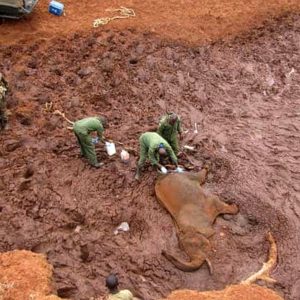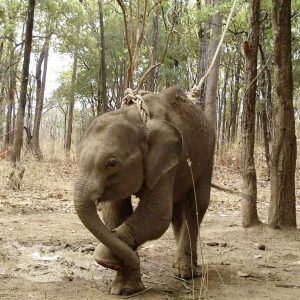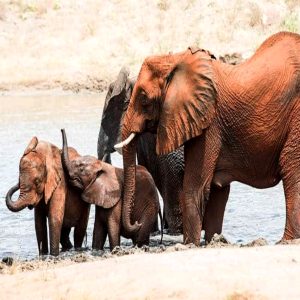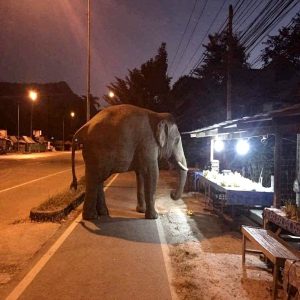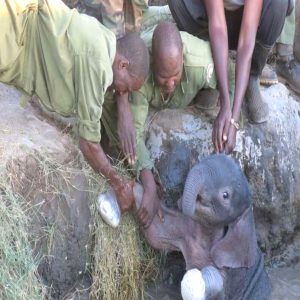The Reteti sanctuary was started in 2016. Katie Rowe, the wife of Jeremy Bastard (Piers and Hillary’s son, who is now CEO of the Sarara Foundation), was one of the forces behind the sanctuary. “We were responding to what we saw as a huge need. It was a time when a lot of elephants were being orphaned to human-wildlife conflict and poaching. There was also drought, so a lot of elephants were being lost,” Katie told me over dinner later that night. If a nursing mom died or was injured, the baby elephant would have no sustenance and was likely to die as well.

“That was the spark,” said Katie. “There were lots of people involved before it fell into place. But it did take years.”
The big issue for the community was that the only sanctuary that rescued baby elephants in Kenya was Sheldrick Wildlife Trust in Nairobi. Sheldrick released the orphans it rescued to the Tsavo Conservation Area in southeastern Kenya, far away from Samburu lands. The community wanted the elephants they rescued to join herds in their local area. Thus Reteti was born.

When the babies came into the corral for their feeding, it was easy to see why the community wanted to keep these babies on Samburu lands. The first group ranged from nine months to about 15 months old. They were beyond adorable.

The second group of elephants to come into the compound were between two to four years old. They enjoyed splashing in the pool and rolling in the mud.

The eldest elephants did not come out because the Reteti keepers were reducing their contact with humans. “We have stopped feeding them milk because they are in a weaning process,” said Dorothy. They are allowed to graze outside and to interact with the wild elephants nearby. Reteti elephants are released at about seven years old, when they are strong enough to chase predators away. Currently Reteti is caring for about 43 elephants.
After the feeding, we were invited inside the kitchen, where Dorothy explained more about the process of rescuing and raising baby elephants.
“Elephants are migrant animals. They move from place to place, depending on the season,” she said. “When one place is dry, they move to another place. They never forget. They keep memories for life. We believe that one day they’ll go back to their right families.”

Some of the stories of the rescued elephants are amazing. Long’uro, who was rescued about four years ago, has no trunk. We wondered if he can ever be released. “We are still learning about what he can do by himself and what he can’t do,” she said, describing how he kneels down to drink and how he positions himself to get showers when the other elephants spray themselves to cool off. Dorothy was cautiously optimistic about his prospects.
The elephants at Reteti are fed four times a day. “We have people working both day and night shifts. It’s always working hours here,” she laughed. The sanctuary has 130 people with permanent jobs, including seven keepers and some management.

In addition, Reteti employs 1,200 village women who have been supplying goat milk to the sanctuary since 2020 during the double whammy of the Covid formula shortage and drought. “It has been life transforming because those women now have power. We have opened bank accounts for them. It started as a trial, and now they are running small businesses in the village, educating their kids and feeding their families very well,” said Dorothy. Counting all the family members, the arrangement is providing food for more than seven thousand people and keeping the community above the poverty level.

Why goat’s milk? According to Dorothy, it’s 90 percent similar to elephant milk. Both animals browse and graze, so their diet is similar. The goat milk is supplemented to bring it up to the calorie level needed by the elephants. Supplements include desiccated coconut, whey protein, spirulina and vitamins.
As our group interview came to a close, Dorothy told us a little about herself. She was almost finished with her certificate in community development and social work when she heard that Retiti was interviewing. She started working in the kitchen with Katie Rowe. “She trained me how to be very strong,” recalled Dorothy. One day she got an opportunity to feed the elephants. “It blew me all through. I stayed there for so long, trying to talk to him. That’s how I got so connected.”

And now? “I don’t think I’ll go away from this place. I’ll always wish to live with elephants because elephants are my babies, elephants are my nephews,” she said with deep affection and wonder at making such a close connection with the animals that are so integral to her tribal lands.
Back in the Land Cruisers, we thought we were heading back to Sarara Treehouses. It was only after visiting Reteti that our Samburu guides took us to see Elephant Rock and told us in detail about the poaching that went on for so many years.

Ian stood in front of the rock and explained that what we were looking at was a portrait of Boris, the bull elephant we had “met” on our dawn ride that morning. Everything was connected, even our place as visitors in this amazing land.
